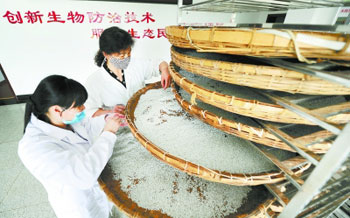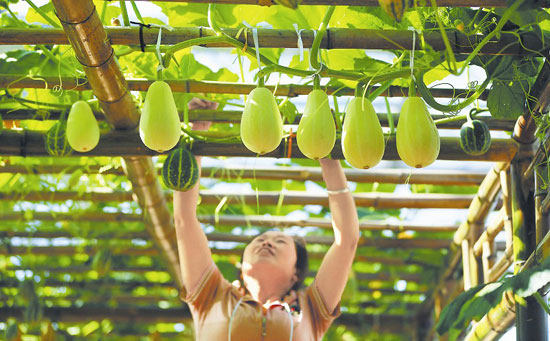"soil method" has great wisdom for Trichogramma to become "rice too old".
Original title: Trichogramma "flying" in rice field
-- Natural enemies control pests and explore new ways to improve the quality of Hunan grain

Staff at Hunan Natural Enemy breeding Center are breeding Trichogramma. (file photo) photo taken by Hunan Daily reporter Guo Liliang
In recent days, the transplanting of early rice in Hunan has reached its peak. As the seedlings were transplanted into the field, batches of Trichogramma were transferred from the natural enemy breeding center of Hunan Province and released into rice fields to deal with rice borers, rice planthoppers and other major rice pests.
At the provincial natural enemy breeding center, staff are busy taking care of box after box of insect eggs, pupae and larvae. Zhou Gang, director of the center, told reporters: "it looks like sericulture, but the purpose is different. We cultivate Trichogramma, the natural enemy of insect pests, which is used to 'attack insects with insects', but can use fewer pesticides and produce high-quality green rice."
On the one hand, the pressure of rice storage in the province is the highest in history, and the circulation of ordinary early indica rice is not smooth; on the other hand, high-grade green fragrant rice is in short supply and still needs to be imported in large quantities. Zhong Wuyun, a provincial rice expert, said that the small Trichogramma, which can improve the green quality of Hunan rice, can be called a "supply-side reform" on the dinner table.
The principle of prevention and control: one thing falls into another.
"the principle of using natural enemies to control pests is actually very simple, that is, 'one thing falls one thing' on the biological chain." Zhou Gang said that we often say that eagles catch snakes and snakes eat mice.
However, in some areas or certain periods of nature, the number of natural enemy insects is often in a state of "outnumbered", and some of them are even completely lack of natural enemy insects, resulting in the proliferation of pests and ecological imbalance.
Five years ago, Hunan's natural enemies were mainly used in forestry. In some scenic spots, there are diseases and insect pests in the forest, it is not suitable to use pesticides, forestry departments turn to use natural enemies to control pests. In 2011, the State Forestry Administration supported Hunan to set up a natural enemy breeding center, which was built by the Provincial Academy of Forestry Sciences. At present, the center has domesticated and raised more than 10 populations of natural enemies, such as Trichogramma, swollen-legged wasps, ladybugs and so on. Liu Yuejin, director of the Forest Prevention Station of the Provincial Forestry Department, said that Trichogramma and swollen-legged wasps have been removed from Zhangjiajie, Huangshan and other scenic spots for several years in a row, and these natural enemies have multiplied themselves, achieving a better effect of sustained pest control and maintaining ecological balance.
In recent years, natural enemies are more and more used in the production of green agricultural products. With the improvement of living standards, people are concerned about the transfer of agricultural products from "have" to "good". The health damage caused by chemical pesticide residues has aroused increasing concern. New operators such as large households and cooperatives have introduced Trichogramma and ladybugs to produce green rice and vegetables.
Trichogramma is the most common natural enemy of rice pests such as Chilo suppressalis, Chilo suppressalis and Chilo suppressalis in South China. Zhou Guosheng, secretary of the party committee of the Provincial Academy of Forestry Sciences, vividly introduced that Trichogramma adults lay eggs in the eggs of pests such as Chilo suppressalis and sojourn by absorbing the nutrition of the eggs of the pests. In this way, the pests will "lose their children and lose their grandchildren."
Breaking through the bottleneck: factory production
On April 13, in the culture room of the provincial natural enemy breeding center, the reporter saw that the dense tussah eggs were attached to a piece of hard paper.
Technical expert Dr. Yan Xuewu said on the spot that as long as it takes three days, these eggs will break their shells, but the ones that come out are no longer tussah silkworms, but Trichogramma which has already been artificially "inoculated" to occupy the magpie's nest. In each "inoculated" tussah egg, there are about 70 Trichogramma waiting for Eclosion.
Yan Xuewu said that Trichogramma can control pests has long been well known in academic circles, and ladybugs eating pests was once common knowledge in primary school textbooks, but these natural enemies were rarely used in practice before, mainly because factory production was not achieved.
"often, when pests become disasters and need natural enemies, natural enemies cannot be produced in time or the number of natural enemies is not enough; and when natural enemies are produced, because they cannot control their growth process, they can only be allowed to develop, unable to keep up with the pace of pest development, and finally lose the effect of control."
Today, this problem has been broken by the provincial natural enemy breeding center. Yan Xuewu told reporters that after continuously tackling key problems, the center's techniques such as artificial cultivation of Trichogramma and precise temperature control and hatching have reached the first-class domestic technology, and successfully developed the first automatic packaging machine for Trichogramma eggs in China, which can achieve "batch and weekly" production and meet the needs of users at any time.
At present, the provincial natural enemy breeding center cultivates 15 billion Trichogramma and other natural enemies every year, which are widely used in the prevention and control of major pests in forests, rice fields and vegetable fields. Hunan "pest special attack team" is famous all over the country.
Natural enemies control insects: midwifery green food
The batch of Trichogramma seen by the reporter has been booked by Hunan Kangqian Agricultural Science and Technology Development Company and will soon be released into the rice field.
In Shijing Village and Shanbi Village, Jinjing Town, Changsha County, Hunan Kangqian Agricultural Science and Technology Development Company has worked for six years and transferred more than 2000 mu of paddy fields. Chen Ruizun, head of the company, said that ordinary rice was planted in the first two years, and high-grade high-quality rice "jade needle incense" was planted in the next four years. Although the current market of ordinary rice is not good, due to less pollution of water and soil, they insist on growing according to the standard of green food, and the benefit of growing grain is still better year by year.
Having tasted the benefits of "good quality, good price", the company introduced Trichogramma, ladybugs and other natural enemies from the provincial natural enemy breeding center this year to control field pests, resolutely not hitting a drop of chemical pesticides and producing zero pesticide and pollution-free paddy, and strive to formally pass the organic rice certification of the state authority.
According to the estimation of the experiment, the Trichogramma and ladybug needed per mu of rice are purchased at the center for only 45 yuan. Zhou Gang said: "if we still pursue conventional yields and use these natural enemies to control rice pests, we can reduce the application of chemical pesticides by 80%; if we all rely on natural enemies to control pests without a drop of chemical pesticides, the yield per mu of rice will decrease slightly, but the grain quality will be greatly improved."
Chen Ruizun is full of confidence in the future: relying entirely on natural enemy insects to produce "jade needle incense" with zero pesticides, if it successfully passes the organic certification, it will be more popular in the market, and the benefit of growing grain can be increased by at least 500 yuan per mu.
■ revelation
There is great wisdom in the native method.
Liu Yong
Using natural enemy insects to control pests, this kind of "soil method" contains great wisdom: only by following the laws of nature can man's wishes be fulfilled.
Once upon a time, in our agricultural production, "wishful thinking" pursued output and applied a large amount of chemical fertilizers and pesticides. As a result, although there was a bumper harvest, the rice was no longer fragrant, the melons and fruits were not sweet, and the delicacies in our childhood memories could no longer be found. Most of the unsalable "cries" of agricultural products on the market lie here.
In the supply-side reform of agricultural production, we should seek more wisdom from the "local methods". There are successful precedents for the application of farm organic fertilizer, Trichogramma pest control, rice and fish farming, and so on, which are worth learning.
If we can "graft" modern science and technology into "native methods" and solve bottlenecks such as convenience and scale, just like the industrial production of Trichogramma, it will certainly be very popular and have great dividends.
■ link
Grain is the focus of agricultural supply-side reform
This year's document No. 1 of the Provincial CPC Committee proposed for the first time to promote the supply-side structural reform of agriculture, and for the first time did not put forward any target requirements for grain sown area and output. In the "opinions on the implementation of supply-side structural Reform in Hunan Province", a lot of attention has been paid to agriculture.
- Prev

Tracing back to the introduction of Shouguang Technology Luzhou vegetables
Tracing back to the introduction of Shouguang Technology Luzhou vegetables
- Next

If we don't plant corn, we will first investigate the pesticide residues.
If we don't plant corn, we will first investigate the pesticide residues.
Related
- A course of planting techniques and methods on how to grow carrots
- How to plant the latest tulips?
- Is it better to pick tea in the morning or in the afternoon? When is the best time for tea to be picked? what is the third or fifth tea?
- Launch Yuanxiao Happy combination Haocha + Tea Yuan healthy Taste
- Penghu Tourism "Fireworks 20 Parade with You"
- 2022 West Lake Happiness holds "Digital Revitalization Voucher" and draws iphone13 and laptop.
- Banqiao Fuzhou social houses are designed to change start-up combined with police elimination to create a safe and livable environment
- The convenient measure of "mechanical weeding" in Xinbei has been abused and the Agriculture Bureau has imposed heavy penalties on the illegal land consolidation.
- Changgeng University Joins Hands with Four Memory Factories to Rescue Memory Talent Shortage
- The list of Taiwan's top 100 MVP managers is listed by the Director-General of the Farmers' Association of Sanxia District.

